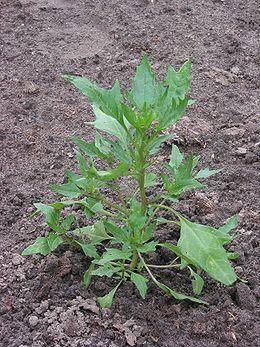The Chenopodioideae are a subfamily of the flowering plant family Amaranthaceae in the APG III system, which is largely based on molecular phylogeny, but were included - together with other subfamilies - in family Chenopodiaceae in the Cronquist system. Food species comprise Spinach (Spinacia oleracea), Good King Henry (Blitum bonus-henricus), several Chenopodium species (Quinoa, Kañiwa, Fat Hen), Orache (Atriplex spp.), and Epazote (Dysphania ambrosioides).
The Chenopodioideae are annual or perennial herbs, subshrubs, shrub or small trees. The leaves are usually alternate and flat.
The flowers are often unisexual. Many species are monoecious or have mixed inflorescences of bisexual and unisexual flowers. Some species are dioecious, like Spinacia, Grayia, Exomis, and Atriplex. In several species of tribe Atripliceae, the female flowers are without perianth, but enclosed by two bracts. The species with a perianth have up to five tepals. The seed is horizontal or vertical, with annular or horseshoe-shaped embryo.
The subfamily Chenopodioideae is distributed worldwide, but originates from Eurasia.
The genera of this subfamily were formerly classified in family Chenopodiaceae in the Cronquist system.
According to Fuentes-Bazan et al. (2012) and based on molecular genetic research, the subfamily comprises 4 tribes and includes about 26 genera:
Tribus Anserineae Dumort. (Syn. Spinacieae), with 2 genera:Spinacia L.: with 3 species in Western Asia and North Africa:Spinach (Spinacia oleracea)Blitum, with 12 species nearly worldwide, for example:Blitum capitatum - Strawberry Blite (Syn. Chenopodium capitatum)Blitum bonus-henricus - Good king henry (Syn. Chenopodium bonus-henricus)Blitum virgatum - leafy goosefoot (Syn. Chenopodium foliosum)Tribus Atripliceae C. A. Mey. (Syn. Chenopodieae Dumort.): Fuentes-Bazan et al. (2012) include here also Chenopodium and related genera, as Chenopodiastrum, Lipandra and Oxybasis.Archiatriplex G.L.Chu, with only one species:Archiatriplex nanpinensis G.L.Chu: endemitic in the Chinese province Sichuan.Atriplex L. - saltbush, orache (Syn.: Blackiella, Cremnophyton, Haloxanthium, Neopreissia, Obione, Pachypharynx, Senniella, Theleophyton), with about 300 species worldwideBaolia H.W.Kung & G.L.Chu, with only one species:Baolia bracteata H.W.Kung & G.L.Chu, endemitic in the Chinese province Gansu.Chenopodiastrum S. Fuentes, Uotila & Borsch: with 5 species, for example:Chenopodiastrum hybridum (L.) S. Fuentes, Uotila & Borsch (Syn. Chenopodium hybridum L.)Chenopodiastrum murale (L.) S. Fuentes, Uotila & Borsch - Sowbane, nettle-leaf goosefoot (Syn. Chenopodium murale L.)Chenopodiastrum simplex (Torrey) S.Fuentes, Uotila & Borsch - Maple-leaf goosefoot (Syn.: Chenopodium simplex (Torrey) Raf.)Chenopodium L. - goosefoot (sensu stricto, incl. Einadia Raf. and Rhagodia R.Br.): with about 90 species worldwide.Exomis Fenzl ex Moq., with only one species:Exomis microphylla (Thunb.) Aellen: a subshrub in southern and western Africa growing in gardens and hedges.Extriplex E.H.Zacharias, with 2 species in western North America:Extriplex californica (Moq.) E.H.Zacharias - California saltbush, California orache (Syn.: Atriplex californica Moq.) Extriplex joaquinana (A.Nelson) E.H.Zacharias - San Joaquin saltbush, San Joaquin orach (Syn.: Atriplex joaquinana A.Nelson)Grayia Hook. & Arn. - siltbush, hopsage (Syn. Zuckia Standl.), with 4 shrubby species in western North America, for example:Grayia spinosa (Hook.) Moq. - spiny hopsageHalimione Aellen - purslane, with 3 species in Europe and Western Asia, for example:Halimione portulacoides (L.) Aellen (Syn.: Atriplex portulacoides L.) - sea purslaneHolmbergia Hicken, with only one species:Holmbergia tweedii (Moq.) Speg., a shrub in Bolivia, Paraguay and Argentina.Lipandra Moq.: with only one species:Lipandra polysperma (L.) S. Fuentes, Uotila & Borsch (Syn. Chenopodium polyspermum L.) - many-seed goosefootManochlamys Aellen, with only one species:Manochlamys albicans Aellen: a subshrub in southern Africa, Namibia and Cape province, growing on rocky an sandy slopes, sand dunes and road sides.Microgynoecium Hook.f., with only one species:Microgynoecium tibeticum Hook.f.: in Tibet and Sikkim, growing in alpine meadows and on disturbed sites.Micromonolepis Ulbr., with only one species:Micromonolepis pusilla (Torr. ex S. Watson) Ulbr. - small povertyweed, in western North AmericaOxybasis Kar. & Kir.: with 5 species, for example:Oxybasis chenopodioides (L.) S. Fuentes, Uotila & Borsch - low goosefoot (Syn. Chenopodium chenopodioides (L.) Aellen)Oxybasis glauca (L.) S. Fuentes, Uotila & Borsch - Oak-leaved goosefoot (Syn. Chenopodium glaucum L.)Oxybasis rubra (L.) S. Fuentes, Uotila & Borsch - Red Goosefoot (Syn. Chenopodium rubrum L.)Proatriplex (W.A.Weber) Stutz & G.L.Chu, with only one species:Proatriplex pleiantha (W.A.Weber) Stutz & G.L.Chu, an annual herb from western North America.Stutzia E.H.Zacharias (Syn. Endolepis Torr.), with 2 annual species in western North America:Stutzia covillei (Standl.) E.H.Zacharias (Syn. Atriplex covillei (Standl.) J. F. Macbr., Endolepis covillei Standl)Stutzia dioica (Nutt.) E.H.Zacharias (Syn. Atriplex suckleyi (Torrey) Rydberg, Endolepis suckleyi Torr.)Tribus Axyrideae (Heklau) G. Kadereit & A. Sukhor., with dendritic trichomes. 3 genera:Axyris L., with about 6 species Central Asia, Himalaya and western China, for example:Axyris amaranthoides L.- Russian pigweed, upright axyrisCeratocarpus L., with 2 species in Europe and West AsiaKrascheninnikovia Gueldenst., with 8 species in Eurasia and North America, for example:Krascheninnikovia lanata (Pursh) A.Meeuse & A.Smit - winterfatTribus Dysphanieae:Cycloloma Moq. (Syn.: Cyclolepis Moquin-Tandon) with only one species:Cycloloma atriplicifolium (Sprengel) J.M.Coulter: widespread in Canada, USA and northern MexicoDysphania R.Br., with about 42 species worldwide, for example:Dysphania ambrosioides - EpazoteDysphania anthelmintica - wormseedSuckleya A.Gray, with only one species:Suckleya suckleyana (Torr.) Rydb., a succulent annual from western North America.Teloxys Moq.: with only one species:Teloxys aristata (L.) Moq. (Syn.: Chenopodium aristatum L., Dysphania aristata): from Eastern Europe to temperate Asia, naturalized elsewhere.
